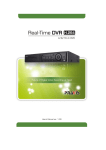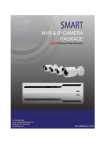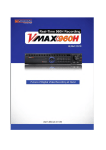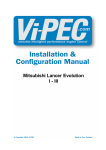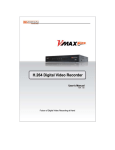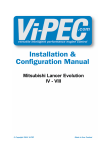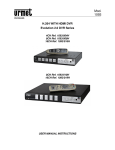Download DVR USER MANUAL - Norbain SD Ltd
Transcript
XDR960 8 & 16 Channel DVR User manual Safety Information Safety Information Before You Begin Read these instructions before installing or operating this product. Note: This installation should be made by a qualified service person and should conform to local codes. This manual provides installation and operation information. To use this document, you must have the following minimum qualifications: A basic knowledge of CCTV systems and components A basic knowledge of electrical wiring and low-voltage electrical connections Intended use Only use this product for its designated purpose; refer to the product specification and user documentation. Customer Support For assistance in installing, operating, maintaining and troubleshooting this product refer to this document and any other documentation provided. If you still have questions, please contact Norbain Technical Support and Sales: Norbain SD Ltd, 210 Wharfedale Road, IQ Winnersh, Wokingham, Berkshire RG41 5TP, England. UK +44 (0) 118 912 5000 Note: You should be at the equipment and ready with details before calling Technical Support. Conventions Used in this Manual Boldface or button icons highlight command entries. The following warning, CAUTION and Note statements identify potential hazards that can occur if the equipment is not handled properly: * Warning: Improper use of this equipment can cause severe bodily injury or equipment damage. ** Caution: Improper use of this equipment can cause equipment damage. Note: Notes contain important information about a product or procedure. This apparatus is manufactured to comply with the radio interference. A Declaration of Conformity in accordance with the following EU standards has been made. The manufacturer declares that the product supplied with this document is compliant the provisions of the EMC Directive 2004/108/EC, the CE Marking Directive 93/68 EEC and all associated amendments. All lead-free products offered by the company comply with the requirements of the European law on the Restriction of Hazardous Substances (RoHS) directive: 2011/65/EU, which means our manufacture processes and products are strictly “lead-free” and without the hazardous substances cited in the directive. The crossed-out wheeled bin mark symbolizes that within the European Union the product must be collected separately at the product end-of-life. This applies to your product and any peripherals marked with this symbol. Do not dispose of these products as unsorted municipal waste. * This symbol indicates electrical warnings and cautions. 3 | H.264 Digital Video Recorder ** This symbol indicates general warnings and cautions. NORBAIN SD LTD reserves the right to make changes to the product and specification of the product from time to time without prior notice. WARNINGS AND CAUTIONS: To reduce the risk of fire or electric shock, do not insert any metallic objects through the ventilation grills or other openings on the equipment. RISK OF ELECTRIC SHOCK User’s Manual | 4 Contents CHAPTER 1 : DVR USER MANUAL 1 GETTING STARTED 7 1.1 Checking Supplied Items 7 1.2 Connecting Peripheral Device 9 1.3 System Startup and Shutdown 10 2 EXPLANATION FOR EACH FUNCTION 12 2.1 Front Panel Error! Bookmark not defined. 2.2 Rear Panel 12 2.3 IR Remote Controller 14 3 OPERATION 15 3.1 User Log-in 15 3.2 Quick Startup Wizard 16 3.3 Live Display Mode 17 3.4 PTZ Operation 22 3.5 Freeze Mode 24 3.6 Call Monitor Operation 24 3.7 Playback of Recorded Video 25 3.8 Simultaneous Live and Playback (Cameo) 26 3.9 Panorama Search 27 3.10 Quick Backup during Playback 28 3.11 Search Recording Image 29 3.12 DST Setting and Screen Saver 34 4 SETTING 36 4.1 System 37 4.2 Device 45 4.3 Record 50 4.4 Network 53 4.5 Backup 57 4.6 Quick Setup 59 5 WEB SURVEILLANCE 60 5.1 Web Login 60 5.2 Web Configuration 60 5.3 Web monitoring 63 5.4 Web Playback 65 5 | H.264 Digital Video Recorder CHAPTER 2 : ACS CLIENT SOFTWARE USER MANUAL 6 ACS USER GUIDE 68 6.1 System Requirement 68 6.2 Install 68 6.3 Uninstall 71 6.4 Basic Operation 72 6.5 Advanced Operation 80 6.6 ACS Setup 84 CHAPTER 3 : MAC ACS CLIENT SOFTWARE USER MANUAL 7 MAC ACS USER GUIDE 92 7.1 System Requirement 92 7.2 Install 92 7.3 Basic Operation 94 CHAPTER 4 : MOBILE PHONE SOFTWARE USER MANUAL 8 MOBILE PHONE SOFTWARE USER GUIDE 104 8.1 iPhone application software 104 8.2 Android application software 114 8.3 Using WAP+3G Connection 125 APPENDIX : DYNDNS SITE REGISTRATION 128 APPENDIX : SPECIFICATION 132 User’s Manual | 6 7 | Chapter 1 : DVR User Manual 1 GETTING STARTED 1.1 Checking Supplied Items Make sure that you have the following items supplied with your DVR. If any of these items are missing or damaged, notify your vendor immediately. Keep the packing utilities for moving or storage purposes afterwards. Items User Manual (DVR & Software) Photo Quantity 1 Set 1 Set Quick Start Guide CD (Manual & Software) and Rubber Mount 1 Set 1 Set (4 Pieces) 12V DC Adaptor Power Cable 1 Set IR Remote Controller 1 Set USB Mouse 1 Set User’s Manual | 8 Ground Screw 1 Set (1piece QVS Rear / 1piece ) 9 | Chapter 1 : DVR User Manual 1.2 Connecting Peripheral Device This section describes how to connect peripheral devices efficiently to the DVR. Install the DVR on flat surface. If required, attach a rubber mount for installation. If a 19-inch rack is used with 1.5U Height case, it is recommend to install the system on a shelf and use 2.5~3U (1U=1.75 inch or 4.45 cm) space for proper ventilation. NOTE Install the system in a location with good ventilation to prevent overheating. [8CH (W)360x(H)66x(D)380mm] [16CH (W)360x(H)66x(D)380mm] WARNING ! When connecting power cord to the system, it is strongly recommended first to plug the power cord to the system and then plug the other side of power cord into the wall AC socket. User’s Manual | 10 1.3 System Startup and Shutdown 1.3.1 System Startup After connecting peripheral devices such as cameras, monitors and a mouse to the DVR, power up the DVR by connecting DC12V 6.67A adaptor to the power jack on the rear panel. The boot log will display as shown below. Please wait until the boot process completes. Login with ‘User Name’ at the login window which will appear as shown below. There is only one Administrator Account configurable in the DVR system. It is assigned with an unchangeable User ID marked as ‘admin’. The default password is empty (No Password). Administrator account has full access to the DVR and its configurable parameters. The Administrator Account also has the ability to create new users and to assign rights to the new user accounts. Those new users created by ‘admin’ account can also login with a specific password set by ‘admin’ account. NOTE Do not forget the administrator’s password that was set for the first time. In case the password is lost, contact your vendor. NOTE The mouse is included. In case you need to replace it, it is highly recommended to choose well-known major brands such as DELL, MICROSOFT, LOGITECH, or SAMSUNG. 11 | Chapter 1 : DVR User Manual 1.3.2 System Shutdown and change password Click the Shutdown button and input password on pop-up to power off the DVR. The default password for ‘admin’ account is none. Therefore, just click ‘Enter’ button on the dial pad. If you changed the password for ‘admin’ account, please type in the changed password to login. NOTE User can type in the password using the virtual keyboard or the numeric buttons on the IR remote controller. User’s Manual | 12 2 EXPLANATION FOR EACH FUNCTION 2.1 Front Panel [4/8/16CH with DVD±RW (W)360x(H)66x(D)380mm] No. Buttons Functions 12 13 Menu Exit Enter Button Direction Button Forward Playback : Decrease the speed / Reverse Playback : Increase the speed Forward play & Backward Play (Long Press) / Pause (Short Press) Forward Playback : Increase the speed / Reverse Playback : Decrease the speed Go to search mode Book-Mark / Used to initiate Instant Reverse Playback Emergency Recording / Used to display full screen video of a selected spot out channel Bring up PTZ Camera control / Used to initiate instant back up Change screen mode / Used to initiate Freeze function USB port (Ver. 2.0) for mouse operation and backup device or F/W update Indicates system status Power, Record, HDD and Remote Control Open system menu / Return to previous mode Select value or setting Move to the direction that user wants to select 14 DVD±RW DVD±RW : Open to use a pre-installed DVD±RW(Option) 1 Fast Rewind Button 2 Forward & Backward Play / Pause Button 3 Fast Forward Button 4 Search Book-Mark / Instant Play (Press and hold) Instant Record / Call Monitor (Press and hold) PTZ I-backup (Press and hold) Mode Freeze(Press and hold) 5 6 7 8 9 USB Port 10 LED Indicator 11 NOTE I- Backup (Instant Backup) In playback mode, the user can press the “I-backup” button on the frontal keypad to configure both “start” and “End” time. Once the “Start” and “End” time is set, click the “Start” button to start the backup process. 13 | Chapter 1 : DVR User Manual 2.2 Rear Panel [8CH (W)360x(H)66x(D)380mm] [16CH (W)360x(H)66x(D)380mm] No. 1 2 3 4 VIDEO-IN LOOP OUT VIDEO OUT SPOT O UT 5 AUDIO OUT 6 7 8 9 10 11 12 13 14 15 16 17 MIC IN VGA HDM I USB Ethernet RS-232C PTZ / KEYBOARD ALARM IN Alarm Output AUDIO IN Power On / Off Switch POWER NOTE I/O Functions Camera Input from CH1 upto CH16 (Auto-detect NTSC/PAL) Loops through output from CH1 upto CH16 Composite Output Progra mmable digital spot output Audio out 1 (Blue) : Main audio output (amplifier) Audio out 2 (Green) : Two-way Audio output Microphone input D-sub 25pin VGA Output True HDMI Output 2.0 USB ports (mouse, backup, F/W update) Gigabit Network port (10/100/1000) Serial port for external devices 2 x RS-485 for PTZ cameras and keyboard controller Alarm Input Alarm output (2 relay output and 2 TTL outputs) Audio input (amplifier) Power switch On/ Off Main power supply connection (Default : 12 V, 6.67A) Carefully check whether the specification of the peripheral devices matches the DVR’s specification. User’s Manual | 14 2.3 IR Remote Controller In order to use IR Remote Controller, the ID of the IR Remote Controller must be same as the ID of the DVR. (Default ID # for DVR and IR Remote Controller is “1”.) If you have more than two DVRs, you are able to control them individually with just one remote controller by setting up ‘Remote ID’. (The Remote ID is adjustable from ‘1’ up to ‘8’.) The function buttons of the IR Remote Controller are as below. No. 1 2 3 4 5 6 7 8 9 10 11 12 13 14 15 16 17 18 19 20 21 Functions Instant (Emergency) Recording Button Numeric Button Auto-Sequence Button on Live Display Mode Freeze Button Call Monitor Button Channel Selection Button Instant Playback Button Search Button OK (Select) Button Audio Mute Button Playback Button on Search Mode (Fast Backward/Playback/Stop/Fast Forward) Exit Button Display Mode Button Zoom Button Bookmark Button Zoom In & Out Button Backup Button PTZ Button Direction Button (Up/Down/Right/Left) Menu Button ID Select Button (DVR1 ~ DVR8) 15 | Chapter 1 : DVR User Manual 3 OPERATION 3.1 User Log-in Check the power connection. The system can be used after power-on. The DVR has various setting categories. The administrator can set the system password and <User> to prevent unauthorized changes to setting values and alteration of recorded file. Enter the <Admin> or <User> password which had been set by using the virtual keyboard. NOTE 1) <LOGIN> window will be permanently displayed in monitor as above picture until user logs in with the right ID and password. 2) If it is set as Auto Log-In, DVR does not require LOG-IN. (Please refer to 4.1.2 User.) User’s Manual | 16 3.2 Quick Startup Wizard Quick Startup Wizard is specially designed to make it much easier for the major DVR settings such as Time/Date setup, Record setup, Network setup and Quick setup. When the DVR boots up, the Quick Startup Wizard operates automatically. It can be disabled by setting in the main menu. 17 | Chapter 1 : DVR User Manual 3.3 Live Display Mode 3.3.1 Full HD(1080p) Live Display Full HD Live Display can be supported in live mode by using its HDMI and VGA output. NOTE In playback mode, the maximum resolution is 960x480 / 960x576(NTSC/PAL). <Full HD Live Display> 3.3.2 Automatic Long Reach (Built-in 4CH) The adjustable 4CH built-in Long Reach Video Amplifier enables to extend the distance coverage upto 900m between camera and DVR. (From CH1 to CH4 only) NOTE Click to enable/disable Looping level control for very video quality by install condition. When Long reach are enabled by distance, it may effect on video looing output User’s Manual | 18 3.3.3 Channel Selection CH selction can be done by CH1~CH16 buttons and display mode can be changed by MODE button. The live images can be displayed on real-time in 1, 4, 9, 16 screen. Whenever the left/right arrow button on the front panel or IR remote controller is pressed, the screen will be sequentially changed. [1 Ch] [4 Ch] [9 Ch] [16 Ch] To select channel by mouse, click target channel to display in full screen live mode. Return to previous display mode is click the screen again. Pop-up menu will be displayed by right mouse click. NOTE To properly select a channel using the mouse, the user is required to perform a slow and clear click of the left mouse button. 19 | Chapter 1 : DVR User Manual 3.3.4 Icons The live mode display’s icons or messages will be indicated on the screen to indicate the system mode or status. Below are the icon categories that are indicated on the monitor. Icon to be shown at Left-upper corner on each channel screen Icon to be shown at Left-bottom corner on full screen. Continuous Recording Sequence display on Motion Detection Recording Digital zoom on Sensor Activating Recording Audio Channel Continuous+ Motion Recording Continuous + Sensor Activating Recording Motion Detection + Sensor Activating Recording Continuous + Motion Recording + Sensor Activating Recording Emergency Recording The sliding menu for display will be appeared when mouse cursor move into bottom and right click of mouse enale to access pop-up-menu. User’s Manual | 20 Red Circle icon button means “instant (emergency) recording”, which is useful to urgently start recording. In emergency recording, the system follows the panic record settings. The default settings for panic record is 30(25)FPS @ 960x480(576) Resolution for all channels. If you want to change the panic record settings for each channel, please go to RECORD Panic Record. Joystick icon button means “PTZ” mode, which is useful to instantly switch to PTZ control. In PTZ mode, user can move pan/tilt and zoom-in/out by moving the mouse pointer, like a virtual joystick. User can click the right-forwarded arrow button to automatically playback the latest video clip. Circle icon button means the HDD usage percentage by video recording. If it shows 60%, then 60% of HDD space has been used up for recording. NOTE If you cannot find any colored-mark in the top right corner of the live screen mode, then it means that the system does not record any image. In this case, you need to check recording schedule or camera of the main setup menu. 3.3.5 Pop-up Menu User can click the right button of the mouse to pop up sub-menu as shown below. When “SEQUENCE” is selected, be sequentially changed. icon is shown on the bottom right corner of the screen, and display screen will When “ZOOM” is selected on full screen mode, digital zoom function is activated and icon is shown and zoomed area will be displayed on the bottom right corne. In zoom pop-up menu, the user can move a yellow box by using the mouse to drag in the desired area of the camera to zoom. In order to go back to live display mode, please click “Zoom” again. 21 | Chapter 1 : DVR User Manual When a camera is disconnected, a warning sound may be generated depending on the system settings. Admin user can set different level of authorization for each user. If a certain user is not allowed to view a certain live and playback channel, then no image appears on the display screen as shown above. User’s Manual | 22 3.4 PTZ Operation User can go to PTZ mode by clicking right button of mouse and selecting “PTZ” in the pop-up menu as shown below or by selecting the joystick button in the menu bar located on the bottom of the main screen. In PTZ mode, user can control PTZ operation with USB mouse. While pressing the left button of mouse, user can drag the mouse pointer to up/down or left/right to move pan/tilt position of the camera. If user moves the mouse pointer far away from the center position of the main screen, the PTZ camera moves at faster speed. The user can also zoom-in/out by rolling the wheel of mouse up or down. NOTE Full PTZ functions are available by using USB mouse, IR remote control, or keyboard controller 23 | Chapter 1 : DVR User Manual For focus control in PTZ screen mode, the user can right-click using the mouse to get the pop-up menu as shown below. Default mode is to “ZOOM”. The user can select “FOCUS” to switch the wheel function of mouse from zoom-in/out to focus. This will change the default behavior of the mouse wheel. The user can also select the preset button or exit PTZ screen model. NOTE User will see numeric pad to select “Preset” number. The preset is defined by setting a PTZ protocol in the setting menu. The maximum number of preset is 255, but the max supported by the PTZ may be less User can automatically switch PTZ camera positions according to the defined of preset setting by using GUARD TOUR function. The connected PTZ camera must support touring functions. “GUARD TOUR” on the pop-up menu can be enabled after the channel that the PTZ camera is connected to is changed to full screen. Please make sure that PTZ camera setting is correct, otherwise, “GUARD TOUR” is shown as disabled. CAUTION Depending on PTZ camera, some preset positions might be skipped if, for example, the PTZ camera cannot mechanically move or control focus within the interval time required by the DVR. In this case, it is recommended to increase the interval setting to a value that allows for the cameras to finish its Pan & Tilt. User’s Manual | 24 3.5 Freeze Mode Press FREEZE button on the front panel, or click the right button on the mouse and select the Freeze mode while viewing a live image. In the Freeze mode, the image pauses; the date/ time information does not; and the system clock continues running. Press FREEZE to pause the live view. To resume the live view, press FREEZE again, or click the right button on the mouse and select the FREEZE again. 3.6 Call Monitor Operation Press the CALL MON button on the front panel, or click the right button on the mouse and select the CALL MONITOR in order to enter call monitor control mode. The numeric panel will pop up at the center of the screen. Click the specific channel button on the numeric panel to display full screen mode out of assigned spot out channels. ▪ Press the close button on the bottom of the numeric panel. It will go back to the previously programmed spot monitor mode. NOTE - A spot out monitor displays another spot out monitor’s video in full screen through the function, call monitor. - In spot sequence setting mode, if Call monitor is selected, spot sequence stops and selected channel pops up. - While call monitor runs, if a channel event happens, Call monitor stops and the event pops up. 25 | Chapter 1 : DVR User Manual 3.7 Playback of Recorded Video To play a recorded image, press the Play button from the Front Panel or IR Remote Controller. It is easy to use the USB mouse to playback recording files. The recorded files can be seen backwards or forwards. Press the rewind and fast-forward buttons, and the playback speed can be controlled in steps of 2, 4, 8, 16, 32 times real time when playing backwards or forwards. User can click playback button playback button in front button to automatically play the latest video clip. It can be performed by pop-up menu and The picture below shows the system playing back a video. In playback screen, user can make various playback modes, make an instant manual backup (archive), go to calendar search mode, change channel, and change screen modes. By clicking the left mouse button in the colored-time bar, the user can jump to a different time in the recording. In addition, user can move the vertical search bar and release by dragging it back and forth to search the desired time in detail. User’s Manual | 26 3.8 Simultaneous Live and Playback (Cameo) 1Channel playback can be displayed in live view mode simultaneously. It’s so called, Cameo function. In live view mode, mouse-right click on the channel that is desired to playback and then select Cameo to activate this function. 27 | Chapter 1 : DVR User Manual 3.9 Panorama Search It will display frame by frame for the selected channel to bring a detail search. In live mode, mouse-right click on the channel that is desired for Panorama search and then select Panorama to activate this function. User’s Manual | 28 3.10 Quick Backup during Playback User can easily archive video while viewing the video playback. In playback mode, user can press and hold “I.BACKUP” button on the front panel to set archive “start time”. After pressing this “I.BACKUP” button, user will see “INSTANT BACKUP START” on the bottom right of the playback monitor. Once “INSTANT BACKUP START” message is shown, user can keep playing back video until user wants to finish archiving and then press and hold the same “I.BACKUP” button again to set backup “end time”. The backup menu window will pop up, and user can select the backup media, like CD/DVD or USB thumb drive and execute archiving. Press “I.BACKUP” button to set “start” and “end” time of archive during video playback. NOTE The “HELP” button will help you understand how to setup several important settings, even without the user’s manual book. For example, if you need help about how to set “BACKUP”, click “HELP” button at the right bottom of the BACKUP menu. 29 | Chapter 1 : DVR User Manual 3.11 Search Recording Image 3.11.1 Date/Time Search The user can select the date and time to search for a certain file within the recorded video. In the calendar, dates in RED color means that there is recorded video data. Click a desired date in Red color. Then, the recorded data for the selected date will be shown. Once the recorded video data of the selected date is shown, user can adjust the vertical search line to the time that user wants to search by dragging a mouse. As the vertical line is moving back and forth, user can see “the Search time” clock is also changing. When user decides the Search time, click Play to see the selected video data. User’s Manual | 30 The colors of the time bar are different, depending on the recording mode. No color - NONE “NONE” means no recording. Even though user set recording frames to and on in “Type” in record setup menu, the DVR will not record. Red color - Panic recording In continuous recording mode, the system records all the time as set by “CAMERA”. Yellow color - Continuous recording Green color - Motion-detection recording In this mode, the system records only when motion is detected In addition, users can set motion-recording configuration in “MOTION ALARM” at the menu setup If user sets “MOTION ALARM” to “OFF” on the “DEVICE” and sets “MOTION” to “SCHEDULE”, then the system will record when motion is detected but motion alarm is not activated. Orange color - Sensor-activated recording In sensor mode, the system will record when a sensor is triggered only during the dwell time as set in “SENSOR” of the “DEVICE” menu. If user sets “SENSOR” to “OFF” in the “DEVICE” and sets “SENSOR” in “SCHEDULE”, then the system will not record anything even though a sensor is triggered. Sky Blue color - “Continuous” + “Motion detection” recording The system records all the time by “continuous” as set by the “CAMERA” in the “RECORD” but will switch recording mode to the motion configuration specified by “MOTION ALARM” in the “DEVICE” menu, if motion is detected in the motion area. The system will also send a “motion event” message to the Advanced Client Software over the network. If user sets “OFF” in “MOTION ALARM” of “DEVICE” and sets “CONT + MOT” in “SCHEDULE”, then the system will record with continuous recording mode even though motion is detected in motion area. Dark orange color - “Continuous” + “Sensor-activated” recording The system records all the time by “continuous” as set by “CAMERA” in the “RECORD” menu but will switch recording mode to the sensor configuration defined by “SENSOR” in the “DEVICE” menu, if a sensor is triggered during dwell time. The system will also send a “sensor event” message to the Advanced Client Software over the network. If user sets “OFF” for “SENSOR” in the “DEVICE” menu and sets “CONT + SENS” in “SCHEDULE”, then the system will record with continuous recording mode even though a sensor is triggered. - “Motion detection” + “Sensor-activated” recording Pink color 31 | Chapter 1 : DVR User Manual The system does not record in normal operation but records only when motion is detected as set by “MOTION” in the “DEVICE” menu and when a sensor is triggered as set by “SENSOR” of “DEVICE”. If user sets “OFF” in both “MOTION” and “SENSOR” in the “DEVICE” menu, then the system will neither record nor notify the Advanced Client Software or Central Management System. Purple color CAUTION - “Continuous” + “Motion detection” + “Sensor-activated” recording The system records all the time by “continuous” as set by the “CAMERA” in the “RECORD” but will switch recording mode to the motion configuration specified by “MOTION ALARM” in the “DEVICE” menu, if motion is detected in the motion area. It will switch recording mode to the sensor configuration defined by “SENSOR” in the “DEVICE” menu, if a sensor is triggered during dwell time. Dark Blue Color The data recorded during DST (Daylight Saving Time) will be indicated in Dark Blue color in the Intelli-Search Bar on playback mode. 3.11.2 Event Log The Event log search is used to find particular event, quickly and easily. Click play icon to play back the selected event data. Users can copy this event list to a USB memory device in text file format. Once a USB memory stick is inserted into the USB port, the user must press “SCAN” button to detect the USB stick and then press “EXPORT” to copy the log information to the media. To see a particular event, move the arrow button of the Front Panel or Remote Controller to the desired time range. The following are the categories indicated on the Event Viewer. 1. 2. 3. 4. 5. Alarm by Sensor Alarm by Motion Alarm by Video Loss Alarm by Panic Alarm by HDD Full NOTE If the Alarm does not activate even though the alarm input setting has been made, check the alarm connection port of the DVR rear panel. User’s Manual | 32 3.11.3 System Log The system log search is used to find particular system log information, quickly and easily. User can copy this event list to USB memory device in text file format. Once export is completed, the user can find a date folder created in USB thumb drive. There is “system.log” file stored in the date folder. The following are the categories indicated on the system log viewer. 1. 2. 3. Log by system Log by setup Log by network NOTE 20 numbers of log record will be shown on one page of the <System Log> and <Event Log> window. User can click the arrow icon to search the log records on another page. 3.11.4 First Data Go to the first screen of the recorded video. This is the oldest video recorded. 3.11.5 Last Data Go to the last screen of the recorded video. This is the latest video recorded. 33 | Chapter 1 : DVR User Manual 3.11.6 Bookmark Go to the bookmark list to search the recorded video data in the bookmark list. Users can make their own bookmark list very simply by click video data by clicking NOTE button, during playback. When you do bookmark search, you can easily playback the bookmarked button, right next to each list. User can press “SEARCH” button on the front panel to get the SEARCH pop-up menu as shown above. In this menu, full search functionality is controlled using the front panel key buttons. User’s Manual | 34 3.12 DST Setting and Screen Saver DST starts at 2:00 local time on 2nd Sunday of March, and ends at 2:00 DST on 1st Sunday of November. During DST (Daylight Saving Time) period, DVR time clock has to be adjusted according to regional time zone. That is, the DVR time clock will be shifted by one hour after the DST settings start, and the DVR will restore the time clock back to normal after DST finishes. To make DST setting on the DVR, go to the menu: SYSTEM > SYSTEM INFO and click “DATE/TIME” to get the DST setting window as shown below. User can setup DST “Begin & End” time after checking “USE DST” box. Since the clock jumps from 2:00 to 3:00, when you go to search mode, you can clearly see there is no data in all channels for one hour due to DST. DST ends at 2:00 DST, and the clock jumps backward to 1:00 standard time on 1st Sunday of November. When DST finishes, there is an hour of overlapped video. The overlapped time video will be indicated in a blue color in the Intelli-Search Bar during playback mode. 35 | Chapter 1 : DVR User Manual When user click on such overlapped period, a message titled “Recorded video Selection” will pop up. The user can then select whether to play DST data or Non-DST data. Click OK to play DST image. [“DST” image is displayed on screen] Click CANCEL to play Non-DST image. [“Non-DST” image is displayed on screen] To make SCREEN SAVER setting on the DVR, go to the menu setup: SYSTEM > SYSTEM INFO and click “SCREEN SAVER” to get the SCREEN SAVER setting window as shown below. Users can select CRT and/or VGA by checking the boxes. Users can set the WAITING TIME for when the monitor will automatically turn off. Users can turn on the selected monitor by clicking a mouse, pressing any frontal key buttons, or pressing any buttons on the remote controller. NOTE WAITING TIME: Users can select the WAITING TIME from NONE, 1,2,3,4,5,6,7,8,9,10,20,30,40,50, and up to 60 MIN. The SCREEN SAVER will not work when either WAITING TIME is set to “NONE” or both SPOT and VGA checkbox are unchecked. SCREEN SAVER may not work, during system upgrade, HDD format, or data backup process. The system continues to record while the monitor is turned off. When it comes to the “AUTO LOGOFF” setting, please refer to the USER setting. User’s Manual | 36 4 SETTING General setting structure consists of “System”, “Device”, “Record”, “Network”, “Backup,” and ‘Quick Setup” as shown below. <SYSTEM> <DEVICE> <RECORD> <NETWORK> <BACKUP> <Q-SETUP> Main Classification SYSTEM DEVICE RECORD NETWORK BACKUP Q.SETUP Sub Classification SYSTEM INFO USER EXPORT/IMPORT HDD FACTORY DEFAULT CAMERA AUDIO SENSOR MOTION ALARM EXTRA ALARM PTZ RECORD SETUP PANIC RECORD LIVE STREAM SETTING SCHEDULE HOLIDAY NETWORK DDNS NOTIFICATION BACKUP QUICK SETUP 37 | Chapter 1 : DVR User Manual 4.1 System The system menu button is selected by clicking “TOOL” on the menu bar or clicking the right mouse button. Users can move mouse pointer from “System” through “Quick Setup” to instantly look around the sub-menus on the menu screen. Using the left mouse button, the user can select a desired category for editing. 4.1.1 System Info Use this submenu to check system information status or to change the system-related configuration. Users can then move to other sub-menu of the System; System Info, User, Export/Import, HDD, and Factory Default by moving mouse pointer or pressing the front arrow buttons. Mac address is a unique network identification number for each system. User’s Manual | 38 In “DATE/TIME SET,” user can activate DST (Daylight Saving Time). Select the time synchronization server and other basic settings like time zone/time format. NOTE There are two types of TIME SYNC MODE. 1) Server Mode The operating DVR is set as a Time Sync Server, which can synchronize the time clock of another DVR(s) connected over same network environment. 2) Client Mode The operating DVR is set as one of the client DVR(s). Input the IP No of designated DVR, Advanced Client Software (ACS), or Central Management System (CMS), as a Time Sync Server in “SYNC SERVER”; and then its time clock is synchronized with Time Sync Server by setup time in “SYNC CYCLE”. Keyboard ID: users must setup Keyboard ID to match the ID setting in keyboard, if user wants to use a keyboard to control the DVR. The user also needs to select the KEYBOARD model and BUAD RATE setting. Remote ID: users must setup the Remote ID to match the ID setting in the IR remote controller in order for the remote to function. Upgrade: Users can easily upgrade the system in “Upgrade” menu via USB/FTP server, upon the selection as shown below: 39 | Chapter 1 : DVR User Manual PROCEDURE CAUTION How to upgrade system firmware by using USB memory stick 1) Insert the USB thumb-drive formatted by FAT32 in any USB port of DVR (compatible with USB 2.0) 2) Once the system detects the thumb-drive, user can see its brand or model name in the “DEVICE” field after pressing the “SCAN” button. 3) Click “OK” to confirm. How to upgrade system firmware by using FTP server 1) Select FTP in the drop-down list and type a given IP address in the Host Address (FTP server IP address) field. Username and password is “none” (Default). *The FTP server address is subject to change without a prior notice. 2) Click ‘Check’ button then DVR will detect the latest Firmware version from the FTP server. If there is a new firmware, DVR will ask you whether you want to upgrade it or not. 3) Click ‘OK’ to confirm it and then click ‘START’ to start upgrading. It is recommended to format the HDD after finishing the firmware upgrade because the data recorded by previous firmware may cause malfunction of DVR due to different format. It is possible to send the system firmware back to factory default. This may be useful if functionality takes a step backwards after a system upgrade. It is highly recommended to check all functions and menus after a firmware upgrade for proper layout and performance. In “Display Setting”, user can set sequence dwell time, spot-out dwell time, spot-out channel, pop-up camera, and OSD as indicated below. User can set Spot-Monitor output and sequence dwell time in this menu as well as show/hide OSD. Transparency is the transparency level of the menu screen. 0% means no transparency at all. User’s Manual | 40 NOTE Spot monitor operation 1. Spot out display mode - It supports programmable multi display mode(Full,4,9,16) on digital spot output. 2. Spot out channel select - Spot out monitor displays selected channels only or spot sequence displays. ** Non-selected channels are not displayed as black screen in covert 3. Spot out cam popup If cam popup is set in Sensor, Motion notify, Spot monitor also pops up the event. 4. Spot Monitor interval - Spot Sequence time setting You may select On/Off for Live or Playback status display by checking a check box. NOTE DVRs support the following video resolutions: 1024x768, 1280x1024,1280x720P,1920x1080P User must set the proper resolution according to the monitor resolution. 41 | Chapter 1 : DVR User Manual 4.1.2 User Master user of this system is always Admin with factory default of No password. Admin must change the password of the DVR for extra security. Admin can designate a new user with different permission levels by: functions, menu access, and live & playback. “Function” is to restrict a user to control certain functions, like search, PTZ control, backup and playback. “Menu Access” is to restrict a user to access certain menu settings, like system, device, record, network, backup, and quick setup. “Live & Playback” is to restrict a user to see both live display and a playback video for a certain camera channel. NOTE Total number of users including administrator is 9 users. User can change the setting, so the DVR does not require login or lock the DVR control. If user selects “On Boot”, the DVR will not ask for an ID and Password input again even though the system reboots. On the contrary, if user selects Auto Log-off and sets the time, the DVR will automatically go to the live display mode that occurs after the set time. Then, the DVR will ask for an ID and Password input when user wants to control the DVR. User’s Manual | 42 4.1.3 Export/Import Users can copy and paste the system configuration values in this menu. “Export” allows the user to copy the settings for this system to USB memory devices. “Import” allows the user to recall the settings saved from other systems using USB memory devices. During import process, make sure that the firmware version of source DVR is the same as the destination DVR. 4.1.4 HDD HDD information is displayed at the menu. (SATA HDD is used in this system.) User can select “Overwrite” or “Rec Stop” when the HDD is full. Users also can easily format a new HDD or an existing HDD for each drive. In order to format a HDD, check the checkbox and then click “HDD Clear” button in the HDD menu. The maximum number of built-in HDD units varies across DVR models. 43 | Chapter 1 : DVR User Manual On the DVR system, DVR Health Check is represented in % sign as shown below. It indicates the lifetime and the temperature in Celcius of the hard disk drive. If system resources are occupied with task, such as making a network connection or performing video playback during the format process, the format may fail. If the format fails, reboot the system resources and then try to format again. [Format completed] NOTE 1) Formatting may take around 40 sec for 320GB, 1 minutes for 500GB, or 7 minutes for 2TB. 2) The system always reserves a maximum of 20GB of space in each built-in HDD to utilize the memory for archiving effectively. User’s Manual | 44 4.1.5 Factory Default With an authorized password, users can get the system back to factory default configuration. NOTE Upon clicking “Start” button and entering the admin password, all the configuration values made by the user will be deleted. The system setting will be sent to factory defaults. The recorded video data will not be erased. 45 | Chapter 1 : DVR User Manual 4.2 Device There are Seven sub menus in the Device menu, such as Camera, Audio, Sensor, Motion Alarm, Extra Alarm, PTZ and POS. 4.2.1 Camera Users can easily move to the “Device” menu by selecting the icon on the top right of the menu screen. Users can setup camera title, covert, brightness, contrast, motion sensitivity, and audio mapping for each camera. “Covert,” also called “hidden camera” feature, hides camera display and playback as if there were no camera recording. Users can apply this covert function not only to Live view, but also to Playback view. The default motion area setup is the entire camera area. User’s Manual | 46 4.2.2 Audio Users can select the audio input and output during live display and match the audio input to a designated channel. (Please refer to Section 4.3.1 Camera Record) There is a volume control panel. User can raise or drop the volume by using the volume control panel. NOTE User can listen to the audio on both live display and playback mode depending on the setting. In addition, users can listen to the audio for both live display and playback mode through the network using Advanced Client Software (ACS), Central Management System (CMS), and/or Internet Explorer web browser. 4.2.3 Sensor Type OFF, N/O (Normal Open) , N/C (Normal Close) The Sensor. Cam Select the associated camera. Notify Users can select how to be alerted when a sensor is activated or motion is triggered by pressing the “NOTIFY” button. The system can generate a buzzer sound and/or make a pop-up screen for the camera in alarm. 47 | Chapter 1 : DVR User Manual CAUTION Relay contact can handle up to 24VDC/1A(or 125VAC/0.5A) of other devices. If connected to a circuit that is over 24VDC/1A(or 125VAC/0.5A), the system may experience problems. Preset User can select the camera to move to a preset position, once the sensor is triggered. (User should setup preset position in PTZ menu 4.2.6 in advance) In addition, users can set multi-preset with a single PTZ camera. Therefore, users can cover a multi-preset zone with a single PTZ camera. Relay 1~2/Off Relay Output. Dwell Time Set the recording period from the start of sensor input activation. During this period, the corresponding camera video will record according to the frame and alarm (relay) output set. The recording stops and alarm output is turned off when the dwell time has elapsed. Copy Setting Upon pressing Copy Settings button, Copy Settings popup will appear. In this popup, choose the sensor the user wants to copy from at the “From” field. Choose the parameters such as Type, Cam, Notify, Preset, Relay, and Dwell Time on the check box. Check on the checkbox next to the sensor numbers to apply the copy setting(s) to another channel on the “To” box. NOTE “Sensor” here means the alarm connected to the DVR, which is triggered by physical sensor input. NOTE If the sensor does not operate properly check the setting of the sensor type (N/O or N/C). The alarm might not function if the actual connecting sensor type and the sensor type in the system setting are inconsistent. NOTE “Camera pop-up” means that multi-screen live video mode will be switched automatically to single channel mode, when an alarm is triggered. This single channel video will be the channel triggered by alarm. User’s Manual | 48 4.2.4 Motion Alarm Select Motion alarm to record only when motion detection is triggered by DVR S/W upon user’s defined motion area. An alarm signal is sent via the selected sensor-out channel. COPY SETTINGS Upon pressing Copy Settings button, Copy Settings popup will appear. In this popup, choose the camera the user wants to copy from at the “From” field. Choose the parameters such as Use, Notify, Relay, and Dwell Time on the check box. Check on the checkbox next to the sensor numbers to apply the copy setting(s) to another channel on the “To” box. NOTE “Motion Alarm” here means alarm triggered by motion detection set by motion menu of DVR. 4.2.5 Extra Alarm S.M.A.R.T. alarm is an alarm signal triggered when the HDD is about to be out of operation. This alarm is created by the HDD and captured by DVR. If the HDD does not create this alarm, then the DVR also cannot capture and output this signal. Users also set the percentage for HDD Usage. For example, when Usage is 50%, DVR will notify by a camera popup or a beep sound when HDD is 50% full. 49 | Chapter 1 : DVR User Manual 4.2.6 PTZ Full control of PTZ camera is available in this menu. For details, please refer to Section 3.3 PTZ Operation. Protocol Select the proper protocol of the connected PTZ camera. Address Set the PTZ driver address of the connected camera. Check the below items for proper P/T/Z operation. 1. Check if the protocol of the connected PTZ camera is correct. 2. Check if the communication settings, including the baud rate, of the connected PTZ camera are in accordance with the assigned value for that P/T/Z protocol. 3. Check if the address of the connected PTZ camera is correct. 4. Check if the wiring to the P/T/Z controllers are correct. PROCEDURE How to setup PTZ camera with Pelco-D protocol (example) 1) Make sure the serial communication with the PTZ camera is through RS-485 port. 2) Select “Pelco-D” at the protocol list, and set the address. 3) Select Baud Rate to be the same as the PTZ camera 4) Click the “Save” button to confirm this configuration. Preset The system supports the number of preset from 1 to 255. Baudrate User can select the baud rate level from 1,200bps up to 115,200bps. User’s Manual | 50 4.3 Record Users can configure various record settings such as Continuous, Event, and Panic for each individual camera channel in the Record Setup Menu. Network Stream settings are independently configured from the Record settings in this menu as well. Therefore, the user can optimize the bandwidth used by configuring the resolution, FPS, and image quality separately. 4.3.1 Record Setup 1. Locate RECORD icon from the main menu and select it. 2. On the Record window Click on Record Setup tab. 3. Choose the desired resolution, frame rate, quality and recording type by using the drop down list items. They are configured by each channel or you may use the copy setting button to apply to other cameras. NOTE COPY SETTINGS Upon pressing Copy Settings button, Copy Settings popup will appear. In this popup, choose the camera the user wants to copy from the “FROM” field. Choose the parameters, such as RESOLUTION,FPS,QUALITY,Event Resolution, Event FPS, Event Quality, PreAlarm and PostAlarm on the checkbox. Check on the checkbox with the camera numbers to apply the copy setting(s) to another channel on the “To” box. 51 | Chapter 1 : DVR User Manual Users can also configure the Network Stream settings independently from the Record settings. Click the “Live Stream” tap and then the Live Stream setting will be seen as shown below. The Live Stream menu enables users to optimize data transmitted over the network by configuring the Resolution, FPS, and Quality without affecting the Record settings. For example, users can configure 960H (960x480) resolution, 15 FPS with Normal quality for Live Stream(for Network) and configure 960H (960x480), 30 FPS with Highest quality for record. Users also have the option to configure Panic Record settings. The Panic Record setting is intended to be used under emergency situations. You engage Panic recording by pressing the “Instant Record” button on the frontal keypad, or clicking the icon from the control panel in live mode. It is highly recommended to use the maximum resolution, FPS, and quality for this record type. User’s Manual | 52 4.3.2 Schedule You can set up the record schedule by applying a various record modes to each date and time. Simply select a record mode by mouse and drag it to the desired date and time. 4.3.3 Holiday Users can setup a specific day of a month or day of week as a holiday as shown below. Once holiday is selected, the recording setup for those holidays will be affected by the schedule setting in the schedule. 53 | Chapter 1 : DVR User Manual 4.4 Network 4.4.1 Network The system has built-in web server. ETHERNET - DVR network system - ETHERNET LAN port Network Type Select network connect type. Select either LAN for fixed (Static) IP or DHCP for dynamic IP. If DHCP is selected, click ‘IP DETECT’ button to detect IP address information. Subnet Mask Subnet Mask address classifies the subnet that the system belongs to. Standard address is 255.255.255.0. For more information, please consult your network administrator or your internet service provider Gateway This is the IP address of the network router or gateway server. It is required when the user wants to connect through the external router from the remote. For more information, please consult your network administrator or your internet provider DNS Server Enter the IP address of the Domain Name Server. There are two DNS settings. (The preferred DNS and the alternative DNS) *You should enter the DNS Server information in order to use internet. (Provided by your ISP) TCP/IP Port Enter the port number to use when connecting locally or remotely. Mobile Port Enter the mobile port number to use when connecting to mobile phones. Web Port Enter the port number to use when connecting from the Web Browser. NOTE TCP/IP Port, Mobile Port, and Web Port should be a different number from each other. User’s Manual | 54 UPnP (Universal Plug and Play) and Auto Private IP Setup (NAT Traversal) UPnP stands for Universal Plug and Play, which is a relatively new technology that indicates a universal protocol for widespread plug-and-play devices to ease the network implementation. When a PC and a DVR both installed the UPnP function, the PC can automatically recognize the DVR in the same local area network. The advantage of this function is that a PC can connect to the DVR directly by clicking on the icon representing the DVR in <My Network Places> folder as shown below. The first five characters of the file name of a detected DVR is subject to a firmware version Simply double click on the desired icon. Then, it will open an internet browser that connects to the DVR via the remote control software as shown below. Please type in your User ID and Password to login and click ‘Connect’ button to connect. Auto Private IP Setup (NAT Traversal) The UPnP NAT Traversal function will help to automatically setup a router if the DVR connects to the internet via a router. When a PC connects to a DVR, which is not in the same local area network, a real IPO address and corresponding port number is required. However if the DVR is behind a router, the communication between the PC and the DVR will be transmitted back and forth by the router. The router will need to setup port mapping (Port Forwarding) before images from the DVR is remotely viewed on the PC. For each individual DVR, the setting needs to be done individually. If the DVR has UPnP NAT traversal function, the setting of the router will be done automatically when it is enabled. Just check ‘Auto IP (NAT Traversal)’ check box in the UPnP setup menu. Then it will take care of Auto IP detect by itself. NOTE The system transfers video images at real-time over the network even during no record. For example, user can monitor live video even when motion has not occurred during motion detection mode. NOTE If there is no physical network connection, it may take a few minutes for the system to start working, since the network configuration in DHCP mode and the DHCP connection cannot be made. 55 | Chapter 1 : DVR User Manual 4.4.2 DDNS The User has to mark the “Use DDNS” check box to use it. DDNS Server joinip.net or joinip2.net is the fixed domain name of DDNS server. User cannot change the DDNS name. NOTE The standard DDNS domain name is joinip2.net, and users can use joinip.net or dyndns.com by drop-down list. User’s Manual | 56 4.4.3 Notification Remote Notify The system can notify an alarm message to the IP address of Advanced Client Software over the network. User can choose from a selection of different kinds of alarms by pressing “ADD.” Alarms can be generated by Sensor, Motion Detection, Disk Full, Admin PW Changed, Video Loss, and Power On/Off. E-Mail Notify The system can send notification to an Email address or Advanced Client Software and the Central Management System over the network. User can choose from a selection of different kinds of alarms by pressing “ADD.” Alarms can be generated by Sensor, Motion Detection, Disk Full, Admin PW Changed, Video Loss, and Power On/Off. By clicking “Use TLS”, users can use a public email address such as Yahoo, Google, Hotmail accounts. Type DVR name in the “DVR Name” box. The DVR name will appear in the email so that users can recognize which DVR sent an email. NOTE Configuration’s first priority is always given to “Schedule Setup ” of the “RECORD” menu. Thus, the system will not send alarm message or email notification upon motion alarm or sensor even though user marks the checkbox of above event selection, unless user sets the “Schedule Setup” in the “RECORD” menu. For example, if user sets “Continuous” only for “Schedule Setup ” of the “RECORD” menu and marks the “All” checkbox in “REMOTE NOTIFY”, then the system will not send alarm messages. In this case, user has to set “C + M”, “MOTION”, “SENSOR”, “C+ S” or “C+M+ S” for REMOTE NOTIFY or E-Mail NOTIFY to function properly. 57 | Chapter 1 : DVR User Manual 4.5 Backup 4.5.1 Backup Users can archive a video clip recorded for a certain period on a selected channel or channels as shown below. Connect an appropriate USB memory device, like USB thumb drive, USB HDD, or a built-in CD or DVD burner and press “SCAN” button to get the system to recognize it before archiving. Necessary file size will be shown before burning. NOTE Backup device shall be a well-known major brand of USB thumb drives formatted by FAT/FAT32 for proper backup. NOTE User can easily backup video in “Quick Backup” during video playback. Refer to section 3.5 for quick backup details. NOTE User can click the “Calculate” button to learn the backup file size before executing backup. NOTE User can rename the backup file name before starting backup process and also put a password in the backup file for security purpose. In order to playback the file, user should input the password. User’s Manual | 58 4.5.2 Backup Video Retrieve There will be a single file after archiving, if “Auto Player” was selected. User can double click “Player.exe” file to open the video data file (PSF format) in the folder. User can print out, capture a still image, zoom out, or make an ASF file format, by using the icons located on top of the player window. NOTE User also can play the backup-video clips by Advanced Client Software and Central Management System. 59 | Chapter 1 : DVR User Manual 4.6 Quick Setup Quick Setup helps user make simple configuration for recording resolution, entire recording speed by frame, recording mode, and recording periods. The system will put the first priority for configuration on this quick setup and will follow this rule regardless of configurations set in other menus. Users should not fill in the checkbox of Use Quick Setup if he/she wants to utilize full system configuration defined in the other menus. NOTE Quick setup must be deactivated if the user requires configuration from the other menus. NOTE After the user marks “Use Quick Setup” to define settings, the system will ignore all other configurations set by full menus. User’s Manual | 60 5 WEB SURVEILLANCE The system has a built-in web server. Using an ordinary web-browser over a network, users can always stay connected to the system for live monitoring, playback, or remote configuration without installing the Advanced Client Software (ACS). 5.1 Web Login The user is required to input the correct IP address in the web browser after making the web port available in the router. After allowing the download of the Active-X file, users can find the login page view seen below. Default USER ID is “admin” and No password. 5.2 Web Configuration Menu of Web Configuration Main Classification SYSTEM DEVICE RECORD NETWORK QUICK SETUP Sub Classification SYSTEM INFO USER HDD DEFAULT CAMERA AUDIO SENSOR MOTION ALARM EXTRA ALARM RECORD SETUP LIVE STREAM PANIC RECORD SCHEDULE NETWORK DDNS NOTIFICATION QUICK SETUP 61 | Chapter 1 : DVR User Manual After logging in with the right ID and password, users can make various configuration changes in the Web Configuration window seen below. This Web Configuration menu is only available to the “admin” account. [System] [Device] [Record] [Network] [Quick Setup] User’s Manual | 62 NOTE This DVR system has its own built-in web server. This web CGI screen is directly supported from the built-in web server in the DVR, regardless of Internet connection. NOTE <System Reboot> enables user to reboot the system without any changes to the setup. When the network is disconnected due to abnormal operation of the system, user can use this function and try to reconnect. However, the IP number assigned to the system may be changed due to the DHCP mode. 63 | Chapter 1 : DVR User Manual 5.3 Web monitoring User has to download Active-X file from DVR and install it at workstation PC before monitoring live video. [Web Active X Install ] User can get into web monitoring after log in as shown below. In order to connect to DVR, the user has to click “ Connect ” button which is located at the top left corner. User’s Manual | 64 User can monitor live video in 1, 4, 9 or 16 screen modes. If user wants to see single channel in full screen, user can double-click on the left mouse button when the cursor is positioned on the live video screen. User can change to single mode by clicking the mode icon located at the bottom left. NOTE The image resolution in “Live monitoring” in this web browser is directly transferred from DVR ( Live image over the web browser depends on the Live Stream value on Record mode of DVR ) NOTE If live image is not properly shown on IE web browser due to network traffic jam or narrow bandwidth, it is recommended to close and re-open the IE web browser. 65 | Chapter 1 : DVR User Manual 5.4 Web Playback Users can remotely playback the DVR images by clicking “SEARCH” button in the middle of bottom window. In order to connect to DVR, the user has to click “ Connect ” button which is located at the top left corner. Playback Time Select the date and time on Time Search, located at the middle of left side of window, and click button. Playback Icon Play/Pause is toggled and playback speed is shown on the left box. Play DST Check this box to play overlapped images during DST (Daylight Saving Time) period. For further details, please refer to Section 3.7 (DST Setting and Image Playback) Intelli-Search Bar User can move the blue vertical line to the time that user wants to search. The colors of the time bar are different by each recording mode. Please, refer to Section 4.3.2 for details on color User’s Manual | 66 Chapter 2 ACS CLIENT SOFTWARE USER MANUAL 67 | Chapter 2 : ACS Client Software User Manual User’s Manual | 68 6 ACS USER GUIDE 6.1 System Requirement Minimum System Requirement. OS CPU VGA RAM HDD WindowXP, Vista Intel Core i5 cpu 2.80GHz ATI Radeon HD 512 4GB 20MB Free space 6.2 Install a. Run Advanced Client SoftwareSetup.exe saved on the included CD. When clicked, the Setup Menu will appear. Follow the setup instructions to complete the installation. 69 | Chapter 2 : ACS Client Software User Manual b. Press if you want to install the program in a different directory. c. Press to move to the next screen. d. Press to move to the next screen. User’s Manual | 70 e. Select what Icons and shortcuts you wish to install on your desktop. Press f. Select to move to the next screen. to begin installation. When the installation is complete, the below message will appear. Select whether you want to launch the software and select “finish”. 71 | Chapter 2 : ACS Client Software User Manual 6.3 Uninstall To uninstall ACS, press UNINSTALL ACS from the Start Menu of your PC. A window will appear in Windows7 or Windows Vista. Press YES to begin the process. When the process is complete, the below message will appear. User’s Manual | 72 6.4 Basic Operation Click on the ACS icon on the Desktop or click START on Windows PC and go to the ACS Folder. 6.4.1 Log In The default ID is Administrator, and there is no default password. The administrator account has the highest level of authority on the ACS. 73 | Chapter 2 : ACS Client Software User Manual 6.4.2 Screen Layout No. Item Description 1 Toolbar ACS Setting, Live Mode, Search, Disconnect, Image Save, Video Save, Screen Mode Remote Setup 2 Site List Panel 3 PTZ Panel 4 Calendar Panel 5 Search Panel Recorded information is shown in search mode Control the speed of Playback and audio 6 Display Panel Transmitted camera images are shown 7 Information Panel 8 Event List Panel Registered DVR Site list PTZ camera control in live mode Search by time and date Shows the current time and site information of the selected channel Event list update User’s Manual | 74 6.4.3 Tool Bar No. Icons Description 1 ACS Setup 2 Live 3 Search 4 Disconnect 5 Disconnect All Disconnect all channels 6 Image Save a selected image 7 Movie Save a selected video (asf format) 8 Print Print out still image 9 Split Single channel, 4-split channel, 9-split channel, 16-split channel 10 Full Full screen mode 11 Time/Event 12 Remote Setup Configure settings of DVR remotely 13 Window control Minimize, Maximize & Exit Advanced Client Software Option setup for Advanced Client Software Showing live images Showing recorded images Disconnect a selected channel Toggle between Search panel & Event list panel 75 | Chapter 2 : ACS Client Software User Manual 6.4.4 Site List Panel - The Site List displays all of the DEVICES that are currently setup for remote connection with the ACS application. To select and view a desired camera or device, simply drag it from the site list panel onto the viewing area. Then, select the options Live or Search ( ). If a DEVICE site is dragged onto the viewable area, then the selected DEVICE or all cameras from the DEVICE will be displayed. User’s Manual | 76 6.4.5 PTZ control Panel PTZ camera control is only available in Live mode. No. Button Description 1 Navigation Key 8 directional arrows allow the user to move the PTZ camera. The PTZ Camera is moved when one of these arrows are pressed to the direction desired, and stops the movement if the mouse button is released. 2 Zoom Zoom In and Zoom Out. 3 Focus Adjust the focus of the PTZ camera. 4 Virtual PTZ If Virtual PTZ is activated, it enables users to control the PTZ camera’s movement, Zoom and Focus. PTZ can be controlled with the mouse on the channel screen directly. 5 PTZ Speed Adjust the PTZ camera response speed. Getting Faster as moves to the right. 6 Preset Set PTZ presets on current view. 7 Go to the preset location. 8 Save the preset location.. 6.4.6 Calendar Panel Calendar panel is only available in search mode. 77 | Chapter 2 : ACS Client Software User Manual - The date is highlighted by red color if the record data exist. - (Go button) should be pressed to start playback from the selected time. - If DST is enabled, the earlier one-hour overlapped video will be shown first. 6.4.7 Search Panel Search panel is only available in search mode. - The Search panel shows the record information for each channel. Each record mode is similar to below. No Record White Continuous (Yellow Color) Panic(Red Color) Alarm(Orange Color) Motion(Green Color) - Click the time or move the time bar to the time you want to playback in the search panel. - For a more detailed search like below, double-click the time that you want to jump into. Detailed search is available on a 2 minute basis like below. User’s Manual | 78 - Playback control panel No. Button Description 1 Go to First 2 Forward Playback : Decrease the speed / Reverse Playback : Increase the speed 3 Step Backward 4 Reverse Playback 5 Pause 6 Forward Playback 7 Step Forward 8 Forward Playback : Increase the speed / Reverse Playback : Decrease the speed 9 Go to Last - Audio control (Audio On/Off): Turn On or Off for Audio channel. Two-way Audio : Two-Audio between ACS and DVR. Relay: Turn On or Off for Relay. 79 | Chapter 2 : ACS Client Software User Manual 6.4.8 Display Channel - Showing Live or Search screen - In Live mode, [Live] will be displayed with all white text information. Blue channel boundary - In Search mode, [Search] will be displayed with all red text information. Red channel boundary - Yellow channel boundary for selected channel 6.4.9 Event List Panel - Update event lists from DVR - Start the playback by double-clicking the list . User’s Manual | 80 6.5 Advanced Operation 6.5.1 Event Search - When you right click on a site in the site list, the quick access menu will be shown. - Select EVENT SEARCH to run Event Search. Description No. Function 1 System Connection Info Input the information of DEVICE to connect. 2 Event Download Status Right after connecting to DEVICE, event information will be downloaded automatically. The download progress bar will be shown. 3 Calendar Search If there is an event in the selected date, the date is highlighted. Select a specific date to start event search. 4 Interval Setup 5 Event List 6 Channel/Event Filter 7 Start/Stop Search Set the interval for event search. The desired date is chosen, the event list of the desired date will be shown on the list. Event information can be sorted by a channel or event type. Start/Stop Search button. 81 | Chapter 2 : ACS Client Software User Manual 6.5.2 Remote Backup - When you right click on a site in the site list, the quick access menu will be shown. - Select REMOTE BACKUP to run Remote Backup. No. Function 1 System Connection Info 2 Recording Directory 3 System Recording Info 4 Backup Setting 5 Channel 6 Backup Progress 7 Backup Status Window Description Input the information of DEVICE to connect. Decide the recording directory to backup. Displays the start and end time of the recorded data in the system. Setup the start and end time of the data to backup. Select the channel to backup. Backup Progress bar indicates the backup process status. Displays the backup status in text message. When the backup process is completed, “Backup Completed” message will appear. User’s Manual | 82 6.5.3 Firmware Upgrade - When you right click on a site in the site list, the quick access menu will be shown. - Select FIRMWARE UPGRADE to run Firmware Upgrade. Description No. Function 1 DEVICE Connection Info Input the information of DEVICE to connect. 2 Firmware File Directory Decide the firmware file directory to upgrade. 3 DEVICE Name/ Current Version Displays the current DEVICE Name and Firmware Version. 4 New Version to upgrade Displays the new DEVICE Name and Firmware Version. 5 Upgrade Progress 6 Upgrade Status Window Start Upgrade and upgrade progress bar shows the upgrade progress status. Displays the upgrade status in text message. When the upgrade process is completed, “Upgrade Completed” message will appear. 83 | Chapter 2 : ACS Client Software User Manual 6.5.4 DeInterlace - User can set DeInterlace function on or off. - Default is off. User’s Manual | 84 6.6 ACS Setup : Options for DEVICE Registration, Network, User, Display, Event and other options. 6.6.1 DVR Registration Add, Modify, Import, Export or Remove DEVICE site information. Ex) Adding a new DVIECE site In order to add a DVR, click ‘Add’ button, and put right information. ** DVRs on UPNP can be detected by ‘Search’ button. Then the IP information is received automatically. 85 | Chapter 2 : ACS Client Software User Manual Description Function 1 Name 2 IP 3 Search 4 Port 5 Web port 6 ID 7 Password 8 Channel 9 Model 10 Aspect Ratio The name of the site. IP Address. Search the DEVICE sites in the same local network. (UPnP function) Port of the site. (Default: 9010) Web Port of the site. (Default: 80) User ID of the site. Password of the site. Number of channel of the site. (for example: 16ch DEVICE: 1-16 or specifically: 1,3,5,7,9) Select a DEVICE or DEVICE’s model name. Select the displayed Aspect Ratio. (Custom, 1:1, 4:3, 16:9) - To modify and/ or remove DEVICE information, click ADD or REMOVE to amend DEVICE site information. Able to export the current site list and save as a file or import the file to the site list. Once the new DEVICE site is added, the new DEVICE information will be displayed at DEVICE site panel as shown below. User’s Manual | 86 6.6.2 User User authority can be changed by Administrator. “admin” is the built-in account for administrating the DEVICE and ACS program. Ex) User authority change User authority can be changed by Administrator. ID cannot be changed but should be removed. 87 | Chapter 2 : ACS Client Software User Manual 6.6.3 Display - Options for OSD setting Title: Able to turn on/off the DEVICE title with the channel number. Date/Time: Able to turn on/off the Date/Time of the site. DEVICE Name: Able to turn on/off the name of the site. Time Format Sync: Synchronize the DEVICE time format to ACS. Record Status: Able to turn on/off the Record Status of the site. Live/Search: Able to turn on/off the Live/Search of the site. User’s Manual | 88 6.6.4 Event - Setup the event port, event type and popup settings for event. No Item Description 1 Port Input the same event port number of DEVICE setting to receive event notification from the DEVICE. 2 Filter Select the type of event to receive. 3 Action Setup the popup duration and enable beep sound. 89 | Chapter 2 : ACS Client Software User Manual 6.6.5 Misc. - Setup the Recording Directory, Language, Auto Upgrade, and Auto Login. Description Function 1 Recording Directory Decide the recording directory to save images and moving images. Video is saved as .ASF or .MP4. 2 Language Select a desired language. 3 FTP Information In order to have Auto Upgrade, input FTP information. Once the FTP setup is done, ACS will detect the latest firmware is in the FTP and start upgrading automatically. 4 Auto Login If you enable the auto login after inputting ID and Password, next time when you login, you don’t need to type in the ID and Password again. User’s Manual | 90 Chapter 3 MAC ACS CLIENT SOFTWARE USER MANUAL 91 | Chapter 3 : MAC ACS Client Software Manual User’s Manual | 92 7 MAC ACS USER GUIDE 7.1 System Requirement Recommended System Requirement OS CPU VGA RAM HDD Mac OS X 10.6(snow leopard) Built-in Intel CPU MAC Recommended More than 128MB Recommended More than 1GB 20MB Free Space Minimum System Requirement. OS CPU VGA RAM HDD Mac OS X 10.5( Leopard) Built-in Intel CPU MAC 64MB 512MB 20 MB Free space 7.2 Install a. Run MAC ACS.pkg on CD, and a Setup Menu appears as below. 93 | Chapter 3 : MAC ACS Client Software Manual b. Select the HDD to be installed. Press the [Continue] button to move to the next screen. c. Press the [Continue] button to move to the next screen d. Press the [Install] button to Install MAC ACS. User’s Manual | 94 e. Put in the password and Click [OK] to begin installation. When the installation is complete, the message appears as below. 7.3 Basic Operation Click on ACS icon on Application Folder 95 | Chapter 3 : MAC ACS Client Software Manual 7.3.1 Screen Layout No. 1 Main Toolbar 2 DVR List Panel 3 Live or Search Connect Panel 4 PTZ Panel 5 Calendar Panel 6 7 Description Item AVS Setting, Live and Search Connect, Disconnect, Image Save, Screen Mode and Change Registered DVR Site List. Possible to connect by Dragging Click Live or Search mode to connect the panel PTZ Camera Control in Live mode Search by Time and Date Search Panel Recorded information is shown in search mode. Control the speed of Playback and Audio as well Display Panel Transmitted Camera images are shown ( Live and Playback ) User’s Manual | 96 7.3.2 Main Toolbar No. Button 1 Site Manager 2 Connect 3 Disconnect 4 Disconnect All 5 Print 6 JPG Export 7 Movie Export 8 Split Description Register or Delete DVR on the list Connect to a site that is listed on the DVR list panel ( Select Live and Search mode at Connect Mode Panel ) Disconnect a selected channel Disconnect All Channels Print out still image Save a selected image to the desktop as JPEG format Save a selected video clip to the desktop as mov format Single Channel, 4-Split, 9-Split, 16-Split 7.3.3 Site List Panel The site list panel shows registered DVR lists. To connect, Drag & Drop the site. Before you connect the site, Select the Live or Search mode first in the connection mode panel. 16 different On-Screen DVR, a mixture of different connection modes can be monitored. 97 | Chapter 3 : MAC ACS Client Software Manual 7.3.4 PTZ Panel PTZ camera controls in Live Mode. PTZ Camera can control if the channel is activated on PTZ operation. No. Button Description 1 Navigation Key PTZ camera can be moved in 8 directions and Whenever click the direction key, it moves slowly. 2 ZOOM Zoom In and Zoom Out 3 FOCUS Adjust the focus of PTZ camera 4 PRESET Select the preset location Go to the preset location 5 7.3.5 Calendar Panel Activated in Search Mode The recorded data will be shown in blue bold with the dot which is located below the number When you click the recorded date on the search mode, the playback time will be detected automatically ( Go Button ) should be pressed to start playback from the selected date and time If DST is enabled, the earlier one-hour overlapped video will be shown first. User’s Manual | 98 7.3.6 Search Panel Activated in Search Mode - The Search panel shows the record information for each channel. - Each record mode is like below. No Record Background Color Continuous (Yellow Color) Panic(Red Color) Alarm(Orange Color) Motion(Green Color) - Click the time or move the time bar to the time you want to playback in the search panel. - Playback control panel No Button Description 1 Go to first 2 Forward Playback : Decrease the Speed / Reverse Playback : Increase the Speed 3 Reverse Playback 4 Pause 5 Forward Playback 6 Forward Playback : Increase the speed / Reverse Playback : Decrease the speed 7 Go 10 seconds before the end of the data. 99 | Chapter 3 : MAC ACS Client Software Manual 7.3.7 Site Manager Add or Modify or Remove DVR site information. Press to register the DVR as follows : The default value is registered User’s Manual | 100 To fix, Double-Click on the item. For example, Double-click “ New Site “ to change the name. After modifications have been made, press No. Function Description 1 Name Fill in the name of the site to be registered 2 IP Fill in the IP of the site to be registered 3 Port Fill in the PORT No of the site to be registered ( Default 9010) 4 User ID Fill in the ID of the DVR to be connected 5 User Password Fill in the PW of the DVR to be connected 6 Ch. Fill in channel of the site to be registered ( ex, 16 Ch DVR: 1-16 or Registered by Camera : 1,3,5,7,9) 7 Model Select Model name of the DVR to be registered Please double click the items, if you want to change the item from the registered information. If you want to delete the registered DVR information, Select the DVR and click After modifications have been made, press 101 | Chapter 3 : MAC ACS Client Software Manual User’s Manual | 102 Chapter 4 MOBILE PHONE SOFTWARE USER MANUAL 103 | Chapter 4 : Mobile Phone Software User Manual User’s Manual | 104 8 MOBILE PHONE SOFTWARE USER GUIDE 8.1 iPhone application software 105 | Chapter 4 : Mobile Phone Software User Manual User’s Manual | 106 107 | Chapter 4 : Mobile Phone Software User Manual User’s Manual | 108 109 | Chapter 4 : Mobile Phone Software User Manual User’s Manual | 110 111 | Chapter 4 : Mobile Phone Software User Manual User’s Manual | 112 113 | Chapter 4 : Mobile Phone Software User Manual User’s Manual | 114 8.2 Android application software 115 | Chapter 4 : Mobile Phone Software User Manual User’s Manual | 116 117 | Chapter 4 : Mobile Phone Software User Manual User’s Manual | 118 119 | Chapter 4 : Mobile Phone Software User Manual User’s Manual | 120 121 | Chapter 4 : Mobile Phone Software User Manual User’s Manual | 122 123 | Chapter 4 : Mobile Phone Software User Manual User’s Manual | 124 125 | Chapter 4 : Mobile Phone Software User Manual 8.3 Using WAP+3G Connection User’s Manual | 126 127 | Appendix : DynDNS Site Registration User’s Manual | 128 APPENDIX : DYNDNS SITE REGISTRATION 1) Go to www.dyndns.com 2) Log in to the Site after registration 3) Click “ Add Hostname“ button on “Host Services” 129 | Appendix : DynDNS Site Registration 4) Put in the IP address and Host name on the blank 5) Click “NEXT” Button 6) Click “Activate Services” button User’s Manual | 130 7) Confirm the domain name and IP address 8) Check the connection status Tip 1. It may take a little time to be completely done for DNS deployment after changed sub domain. 2. Please recheck DVR’s IP address registered in the My Service Menu, if you can’t access DVR using dyndns. 3. If you are using dyndns to change the IP address for the DVR to the update request, dyndns update by the circumstances that may be late. 4. Dyndns domain is registered by the policy. If the update occurs frequently, it may be blocking. Please recheck DVR’s service status registered in the My Service Menu, if you don’t access dyndns. 5. If you don’t access dyndns for a long time, domain will be deleted automatically. To prevent this, please access it regularly, or you will have to pay for it again. For more information, please contact to dyndns directly 131 | Appendix : Specification User’s Manual | 132 APPENDIX : SPECIFICATION MODEL XDR960-08 XDR960-16 Photo Compression Algorithm H.264 HDD Interface 2EA X SATA I / II OS Embedded Linux Input 8 BNC / 16 BNC Looping 8 or 16 x Loop out ports Video Video Mode NTSC / PAL Auto Detection Display Speed (NTSC/ PAL) 480 / 400 fps @ 960H Screen Split 1, 4, 9, 16, CAMEO (1ch) Monitor 3ea x Main Monitor (HDMI , Composite, VGA) 1 x Digital Spot out (Full, 4, 9, 16 Mode) Display Resolution 1024x768, 1280x1024,1280x720P,1920x1080P Video-Out Recording Speed (NTSC/PAL) 1, 4, 9, CAMEO (1ch) 480x240 / 288 240 / 200 fps 480 / 400 fps 960x240 / 288 240 / 200 fps 480 / 400 fps 960x480 / 576 240 / 200 fps 480 / 400 fps Recording Resolution NTSC : 480x240, 960x240, 960x480 PAL : 480x288, 960x288, 960x576 Recording Modes Time-Lapse, Event, Pre-Event, Post-Event, Instant(Panic) Record Speed x1, x2, x4, x8, x16, x32 1, 4, 9ch (Multi-Channel Playback) Playback & Search Function Audio Input / Output/ MIC Alarm Input / Relay Output 1, 4, 9 & 16ch (Multi-Channel Playback) Date/Time, Record Table, Calendar, Event preview, Bookmark, Play from Search, System Log, Panorama Search, Cameo Search In 8,16 / Out 2 / 1 x MIC 8 x In / 2 x Relay Out 16 x In / 2 x Realy Out P/T/Z Control and Port Virtual Joy-Stick control on screen (by mouse) LAN 1x10/ 100/ 1000Mbps Gigabit Ethernet 133 | Appendix : Specification MODEL XDR960-08 XDR960-16 240/192 fps @ 960*480(576), 480/400 fps @480*240(288) Network Transmission Video Dual-Stream (Local Recording & Network Transmission) Function Live Monitoring, Remote Playback and File Backup (Triplex-on-Remote) Remote & E-Mail Notification with JPEG, Remote System Reboot by Client(ACS&CMS) Mobile Device support iPhone, iPad, Backberry, Android, 3G mobile Remote PTZ Control Pan / Tilt / Zoom / Focus / Iris Long Reach Video Equalizer 1~4Ch up to 900Meter (3,000ft) Remote Management Backup Device Software ACS Client S/W & CMS Web (IE) Live Monitoring, Playback & System Configuration Internal Bulti-In DVD (Optional) External Local Backup by USB Memory Stick(2ea), Network Backup by CMS Support Advanced Functions Long Reach Video Amplifier (Built-in 4Channel) Multi-Language, System Upgrade by USB & Network, Help menu on Major Function, Call Monitor Configuration, Import & Export, & Instant File Backup Warning Alarm for System Over-Temperature System Operation IR Remote Controller, USB Mouse, Front Keys Power 12V x 6.67A D/C Storage Temperature and Humidity -20~60°C / 20~95% RH Operating Temperatureand Humidity 5~40°C / 20~80% RH Certification CE & , RoHS NOTE The specifications are subject to change without notice










































































































































